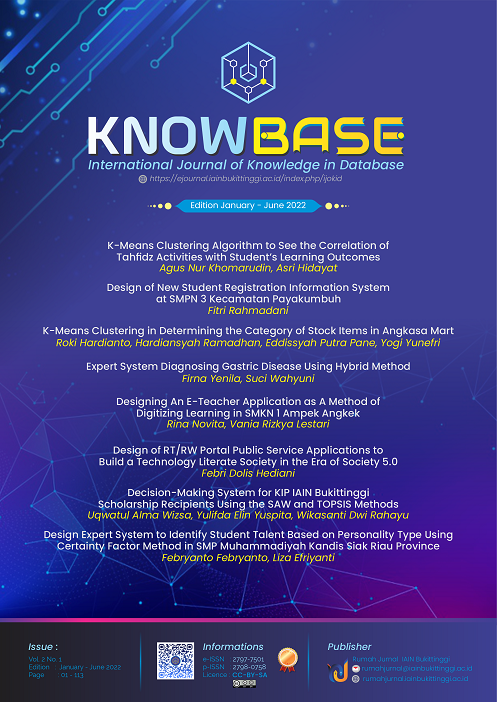Design Expert System to Identify Student Talent Based on Personality Type Using Certainty Factor Method in SMP Muhammadiyah Kandis Siak Riau Province
DOI:
https://doi.org/10.30983/ijokid.v2i1.5587Keywords:
Information System, R&D Method, Waterfall Development Model, PHP/MySQLAbstract
The goal of this research is to create a system design that "can assist parents and teachers in recognizing the talents of their students" based on the child's personality, so that parents and teachers can provide "the right education and learning patterns for students". The author discovers that there is no expert system in SMP Muhammadiyah Kandis to identify children's talents based on personality type using certainty factor methods, and that at SMP Muhammadiyah Kandis, evaluations are still done manually and only to determine intelligence, not to determine student talent. The research method that the author uses is the Research and Development method, where the development method that the author uses is the Waterfall method according to Pressman, which the stages consist of Communication, Planning, Modeling, Construction, Development.‎ Based on the findings of the authors' research, the authors were successful in creating this research product, with the functional suitability test results from two experts obtaining a feasibility value of 100%, which was declared Very Fair, and the compatibility test results obtaining a feasibility value of 100%, which was declared Very Eligible and the feasibility score for the usability test was 86.3%, which was declared Very Eligible, and the feasibility score for the material result test was 81%, which was declared Very Eligible, and the feasibility score for the Indonesian linguistic test was 87.5%, which was declared Very Eligible. The aim of this study is to develop a expert system to identify children's interests and talents that are validated and worthy of being operated.
References
L. Efriyanti and F. Annas, “Aplikasi Mobile Learning Sebagai Sarana Pembelajaran Abad 21 bagi Pendidik dan Peserta Didik di era Revolusi Industri 4.0,†J. Educ. J. Educ. Stud., vol. 5, no. 1, p. 29, 2020, doi: 10.30983/educative.v5i1.3132.
E. Maiyana, “Perancangan Aplikasi Media Informasi Lowongan Kerja Perusahaan Bagi Pencari Kerja Berbasis Web,†J. Sains dan Inform., vol. 3, no. 2, p. 118, 2017, doi: 10.22216/jsi.v3i2.2893.
A. A. Muhammad Ahat, “Jurnal Kajian Kegamaan dan Kemasyarakatan,â€J. Kaji. Kegamaan dan Kemasyarakatan, vol. 02, no. 02, pp. 43–54, 2018.
S. Shabri, “Hubungan Tipe Kepribadian Dengan Motivasi Belajar Pada Mahasiswa Kurikulum Berbasis Kompetensi Fakultas Keperawatan Universitas Syiah Kuala,†Idea Nurs. J., vol. 7, no. 2, pp. 1–12, 2016.
N. A. Hasibuan, H. Sunandar, S. Alas, and S. Suginam, “Sistem Pakar Mendiagnosa Penyakit Kaki Gajah Menggunakan Metode Certainty Factor,†Jurasik (Jurnal Ris. Sist. Inf. dan Tek. Inform., vol. 2, no. 1, p. 29, 2017, doi: 10.30645/jurasik.v2i1.16.
D. Putu and S. Dewi, “Sistem Pakar Diagnosa Penyakit Jantung dan Paru dengan Fuzzy Logic dan Certainty Factor,†vol. 2, no. 3, pp. 361–370, 2014.
R. A. Sundari and H. A. Musril, “Pengembangan Sistem Informasi Database Alumni ( Studi Kasus : SMAN 1 2x11 Enam Lingkung ),†J. Telemat., vol. 15, no. 2, pp. 115–124, 2020.
M. R. Darmawan and H. A. Musril, “Perancangan Sistem Pendaftaran Audiens Seminar Proposal di Institut Agama Islam Negeri (IAIN) Bukittinggi,†J. Teknol. dan Inf., vol. 11, no. 1, pp. 26–39, 2021, doi: 10.34010/jati.v11i1.3346.
R. Okra and Y. Novera, “Pengembangan Media Pembelajaran Digital IPA Di SMP N 3 Kecamatan Pangkalan,†J. Educ. J. Educ. Stud., vol. 4, no. 2, p. 121, 2019.
A. M. Afrilia, “Personal Branding Remaja di Era Digital,†Mediat. J. Komun., vol. 11, no. 1, pp. 20–30, 2018, doi: 10.29313/mediator.v11i1.3626.
Downloads
Published
How to Cite
Issue
Section
Citation Check
License
Copyright (c) 2022 Febryanto Febryanto

This work is licensed under a Creative Commons Attribution-ShareAlike 4.0 International License.
Authors who publish with this journal agree to the following terms:
- Authors retain copyright and grant the journal right of first publication with the work simultaneously licensed under a Creative Commons Attribution License that allows others to share the work with an acknowledgment of the work's authorship and initial publication in this journal.
- Authors are able to enter into separate, additional contractual arrangements for the non-exclusive distribution of the journal's published version of the work (e.g., post it to an institutional repository or publish it in a book), with an acknowledgment of its initial publication in this journal.
- Authors are permitted and encouraged to post their work online (e.g., in institutional repositories or on their website) prior to and during the submission process, as it can lead to productive exchanges, as well as earlier and greater citation of published work (See The Effect of Open Access).



